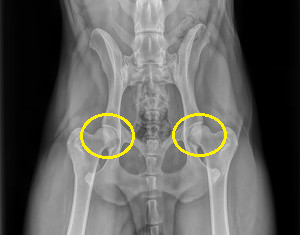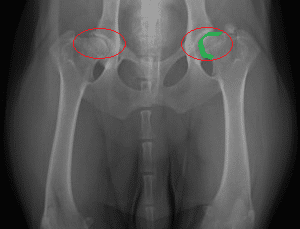Rottweiler health: What to do if your Rottweiler has hip dysplasia
Being a dog parent to a Rottweiler is an amazing and fulfilling experience but it also comes with great responsibility.
Like other medium to large dog breeds, Rottweilers are prone to certain diseases because of their genetics. Hip dysplasia is one of the most common and physically debilitating diseases that your dog may suffer from in their lifetime.
The disease is so common among certain dog breeds, including Rottweilers, that it has gained a bad reputation among dog owners and with good reason. If left untreated, hip dysplasia can drastically affect your Rottweiler’s mobility and by extension its quality of life.
A healthy Rottweiler’s lifespan is usually around the 8 to 12 years range. And it is our responsibility and privilege to make those years wonderful for our beloved pet. One way we could do so is to ensure their overall health. This entails educating ourselves about common diseases and proper treatment.
You can begin with here by learning about the disease’s causes, symptoms and myriad possible treatment options.
What is hip dysplasia?
The official medical term for the disease is canine hip dysplasia (CHD) so as not to be confused with the similar illness that afflicts humans.
While is has been believed to be a hereditary health condition in today’s findings since it is usually found in medium to large purebred dogs, it is believed to be more caused by environment or lifestyle. Canine hip dysplasia is primarily characterized by the abnormal hip joint structure that can develop as your Rottweiler ages, although there are some cases of CHD found in younger dogs as well. This abnormality includes the laxity of the muscles, connective tissues, and ligaments in your dog’s hip area.
To put it simply, canine hip dysplasia is a malformation in a dog’s hip joint, which is a ball-and-socket joint, that results in the development of a shallow socket and deformity of ball. This condition can then result to your dog developing arthritis, another degenerative condition that can greatly affect your dog’s mobility and quality of life.
CHD may affect one or both of your Rottweiler’s hip joints.
To give you an idea on what happens to your Rottweiler’s body when it develops canine hip dysplasia, let’s familiarize ourselves with what a normal and healthy hip joint looks like.

 Source: Pointseastwest.com
Source: Pointseastwest.com
Circled in yellow are what a dog’s hip joints should normally look like. See how the ball of the leg bones are rounded and fits the shape of the hip socket almost perfectly.
While the green highlight, it traces the shape of the ball of the bone and notices how it’s not perfectly rounded anymore. Some areas seem to have rubbed off.
What causes hip dysplasia in Rottweilers?
As mentioned above, canine hip dysplasia could be a hereditary disease and Rottweilers, together with other large dog breeds, are unfortunately more prone to this disease.
But aside from genetic predisposition, there are also other factors that may lead to your dog eventually developing CHD.
For one, Rottweilers who grew up undernourished and over exercised become more susceptible to CHD even though their biological parents didn’t suffer from the disease. Rottweilers, believed to be descended from the muscular Mastiff-like dogs from ancient times, have a large body mass which could put strain on not just the hip joints but on other parts of their body as well. The case is also similar for overweight and under-exercised Rottweilers.
It is important to note that medium to large dog breeds have specific nutritional needs to aid proper growth. It is important to only feed them food that meets these needs and not anymore or any less. Overnutrition can have adverse effects in your Rottweiler’s health as it can lead to excessive growth which then may lead to early onset of canine hip dysplasia.
How will I know if my Rottweiler has hip dysplasia?
Of course, official diagnosis can only be done by your veterinarian. They will do a series of physical exams and X-rays to ensure your dog’s condition.
But you can still watch out for these physical manifestations to catch CHD.
- Decrease in your dog’s physical activity (includes difficulty in doing basic movements such as rising or climbing stairs)
- Sudden limp-walking or change in gait
- Sudden enlargement of your Rottweiler’s shoulder muscles (due to compensation of lack of ability of the hind part of the body)
What can I do to treat my dog’s condition?
The type of treatment for your dog’s CHD will depend on the severity of the disease and your dog’s physical condition as well as its age. But don’t worry, there is an abundance of both non-surgical and surgical treatments available today.
Non-surgical treatments
The focus of non-surgical treatments if the restoration of your dog’s mobility and comfort. Non-surgical treatments can range from medications and supplements to complete lifestyle changes.
Canine hip dysplasia medications and supplements usually target the treatment of pain and inflammation in your Rottweiler’s hip area. Some examples of supplements are Glucosamine Chondroiton Tablets which repair bone cartilage damage caused by CHD, Omega-3 supplements for fighting inflammation and Methy-sulfonyl-methane (MSM) for pain relief and anti-inflammation.
Meanwhile, medicine such as Buffered Chewable Aspirin and injectable osteoarthritic medicine like Rimadyl and Previcox are used by veterinarians to treat dogs with CHD.
Surgical Treatments
Surgical treatment should only be valued as a last resort in the treatment of your dog’s CHD as they can be dangerous and of course pricey.
There are different types of surgeries reserved for the treatment of canine hip dysplasia depending on the severity of the disease and a dog’s overall health condition. Here are some of them:
Femoral head ostectomy (FHO): This surgery entails the removal of the ball part in your dog’s hip joint. FHO is only reserved for dogs with CHD that have developed into severe arthritis.
Triple osteotomy: This operation involves the cutting of the dog’s pelvis in three places. The bone will then be rotated to realign it better with the ball part of the hip joint. If successful, this procedure will eliminate pain and looseness in your dog’s hips. A warning though, tripe osteotomies are reserved for younger dogs.
Total hip replacement (THR): As the name implies, this procedure involves the removal and replacement of the entire hip joint with an artificial plastic and stainless-steel ball and socket. This specialized surgery is usually the last resort for those dogs who didn’t respond to other treatments.
Canine hip dysplasia is one of the most common and serious diseases that your Rottweiler may incur. But don’t worry, it is a treatable and sometimes preventable condition. Plenty of surgical and non-surgical treatments are available today. Just be sure to thoroughly consult first with your veterinarian before beginning treatment.
We hope that this article has been helpful to you! And feel free to check out our other Rottweiler health articles for your other health queries.
